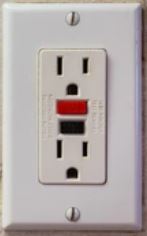The National Electric Code requires that GFCI outlets be installed where there is likely to be wetness or moisture. GFCI is an abbreviation for Ground Fault Circuit Interrupter. Sometimes the initials GFI are used. These areas include garages, basements, kitchen and bathrooms. A GFI outlet is a very sensitive circuit breaker, much more sensitive than the circuit breakers in your main electric panel. The GFCI will “sense” the difference in the amount of electricity flowing into the circuit to that flowing out, even in amounts of current as small as 4 or 5 milliamps. The GFCI reacts quickly (less than one-tenth of a second) to trip or shut off the circuit.
Typically, One set of wires will be the “line,” or power supply; these are connected to the electric panel. The other set will be the “load,” which carries power to additional outlets on the same circuit. A GFCI outlet, properly installed, will protect all the outlets on the “load” side. Some people want to know how many electric outlets can be in series with (or downstream from) the actual GFCI outlet on the load side. Actually, there’s no limit. A standard GFCI will protect up to 20 amps, drawn from any combination of receptacles, either the built-in one or any number of additional ones connected to its load terminals. In practice, up to 7 downstream outlets are usually installed. The benefit is that all of those in-series, downstream outlets are protected by the one GFCI outlet. The disadvantage is that when the GFCI outlet trips (loses power), every single outlet in series will also lose power.
Many homeowners have a freezer and/or refrigerator in their garage or basement. Those appliances are plugged into a GFI-protected outlet. Sooner or later, that GFI will trip and the electric power to those appliances will be lost. When that happens, and the homeowner doesn’t know about it, all the food in the refrigerator and freezer will be spoiled. Up to several hundred dollars worth of food will have to be thrown in the garbage.
GFCIs can trip for a number of reasons: wear and tear on the mechanical parts, erosion, worn out insulation, an electrical surge even from a close lightening storm. Also note that GFCI outlets cannot be reset remotely which is an excellent safety precaution. There could be a serious electrical problem that needs to be resolved by an electrician. But, if the homeowner is very far from home, knowing when that GFI trips or even knowing if the entire house has lost power would be extremely important. Remedial action can be immediately taken. The food in a refrigerator will last only 4 hours without power; a half full freezer will last only 24 hours. Even for times less than those, the food will begin to get warm and should probably not be eaten.
Our product, GFI Notify, for a one-time investment of only $49, will inform the homeowner (and 2 additional contacts) within 4 minutes after a power failure. The app will send emails and text messages with that information. Remedial action can be taken. For example, a trusted person can enter the premises to see if the GFCI can be simply reset. If not, extension cords can be used to plug those appliances into live outlets in the house until the homeowner returns home. Hundreds of dollars worth of food will be saved. GFI Notify also includes 2 free smart plugs. Our app detects whether the GFI has tripped or whether the entire house has lost power. Power restored messages are also sent.
The fact is: GFCI outlets do trip. GFI Notify provides assurance and peace of mind. GFI Notify is also great for monitoring heated aquariums and sump pumps. Even power status in other physical locations can be monitored.
Finally, some have suggested that a homeowner should just install a dedicated line to power garage or basement appliances. That is certainly a solution, but a potentially a very expensive one. Typically an electrician-installed dedicated line can be $500 and up.

